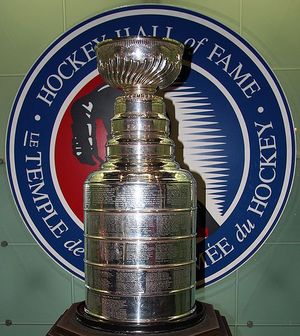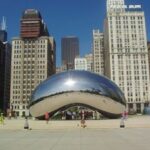To be honest, I am a casual hockey fan at best. My interest in the sport has been piqued this year by the success of the Chicago Blackhawks. I have gained a new found respect for hockey as I have followed along during the Playoffs, but I still have a rudimentary knowledge of the rules and history of this professional sport.
Growing up in Central Illinois I spent my summers playing baseball. Hockey was simply not a sport played by the neighborhood kids I grew up with. To me, it was a game played in Canada and the only thing about hockey which I even had a passing interest in was the fighting. Over the years however as my interest in all sport increased I of course learned the NHL championship trophy was called the Stanley Cup, but I never knew why. Oh I knew it was named after some guy but this was the extent of my knowledge. With my attention now focused on hockey as the Hawks edge closer to that Stanley Cup, I decided to do some investigating.
Even though hockey is not quite as popular in this country as football, baseball, and basketball its championship trophy, the Stanley Cup, is probably the most recognizable. Most sports fans can tell you the trophy is named for a Lord Stanley, but who was this guy, and how did such an esteemed and prominent professional sport’s championship come to be named after him?
According to Legends of Hockey as posted on their website legendsofhockey.com, “The Stanley Cup, notably the oldest trophy competed for by professional athletes in North America, was donated in 1892 by Sir Frederick Arthur Stanley, Lord Stanley of Preston and son of the Earl of Derby.
At this time Lord Stanley of Preston was also the Governor General of Canada. The trophy was actually a silver punch bowl Lord Stanley purchase for 10 Guineas which was about $50.00 at that time. The Cup was originally inscribed as the Dominion Hockey Challenge Cup, and it was given to Canada’s top-ranking amateur hockey club each year. It was not until 1926 that the NHL took possession of the Cup. It was another 21 years however when in 1947 the Stanley Cup became the official championship trophy of the NHL.
The original bowl is now on permanent display at the Hockey Hall of Fame in Toronto. The Stanley Cup that is given to the NHL champs is called the “Presentation Cup” as it is presented to the championship team. It was created in 1963 by a Montreal silversmith. Fans can recognize this Cup by the seal of the Hockey Hall of Fame which is etched on the bottom of the Cup and can be seen clearly when the winning teams’ captain lifts the Cup over his head.
One of the more notable traditions associated with the Stanley Cup, and something unrivaled by any of the other professional or amateur sports is that each player and member of the team’s front-office gets to keep the Cup for a 24-hour period after winning the championship.
According to Sean Gregory in his article, The Stanley Cup, “When Lord Stanley of Preston, the Governor General of Canada, purchased the Cup for $50 in 1893, he never anticipated that a goalie would use it as a popcorn bowl in a movie theater, like New Jersey Devils’ Martin Brodeur did over a century later.
Due to this unparalleled tradition, the Stanley Cup has been at the bottom of Mario Lemieux’s swimming pool and at a variety of strip clubs – most notably with Mark Messier at Scores in New York. A Kentucky Derby winning horse, Go for Gin was allowed to eat feed out of the Cup, and Steve Yzerman even showered with Lord Stanley’s Cup. The Cup has been all over the world as well including in a combat zone in 1997.
According to Wikipedia, “During the trip to Kandahar, Afghanistan from May 2 to May 6, organized by the NHL, the Hockey Hall of Fame, the NHL Alumni and the Canadian Department of National Defense, the Cup was put on display for Canadian and other NATO troops. It briefly came under missile attack on May 3, but emerged unscathed.”
The Stanley Cup in its current version is made of a silver and nickel alloy. It stands at 35 and ¼ inches tall and weighs in at 34 and ½ pounds. It consists of a bowl, collar, shoulder, barrel, and base. The rosters of each team to win the Cup are engraved along the many areas with the first roster being engraved in 1906. Currently there are 2163 individual players engraved on the Cup with more added each year.
According to Legends of Hockey as posted on their website, “Overshadowing all other championship trophies in sports, the legend and glory of the Stanley Cup continues to live in the dreams of hockey players and fans alike.”
Lastly, Sean Gregory had this to say in regards to the Stanley Cup which I feel is the best way to end this article, “Blemishes and all, the Stanley Cup is a beauty. What other trophy may show up at your local tavern for a shot or two? But, if you happen to see the Cup this summer, please keep it clean. And do yourself a favor: no matter how psyched you are to see the trophy, keep your lips off Stanley.”
“Engraving Facts, Firsts, & Faux Pas”, Legendsofhockey.net
“History”, Legendsofhockey.net
Sean Gregory, “The Stanley Cup”, Time.com
“Stanley Cup”, Wikipedia.org





